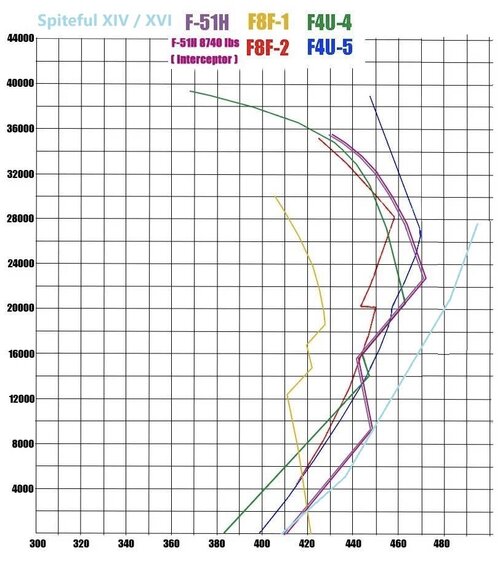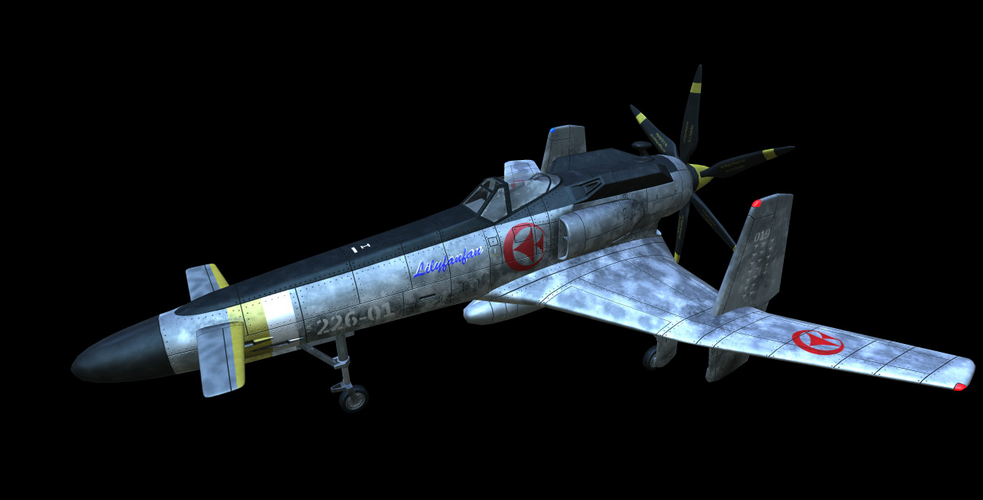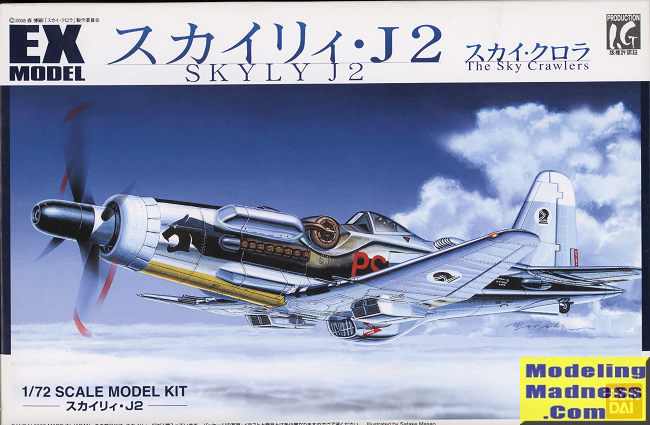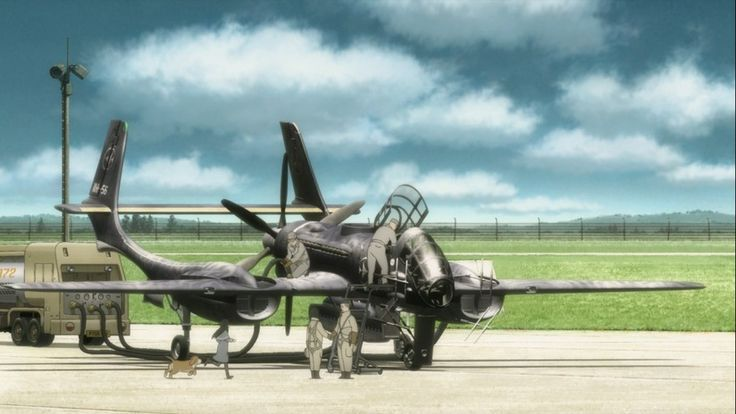Must browse that !
The Sky Crawlers franchise
The Sky Crawlers franchise
Heinkel He P.1076I wonder how the He P.1076 could've fared as well.
I wonder how a supersonic propeller could've worked. A quick Google search states that propellers lose efficiency by 480MPH/770KPH (though I would like to see a source for that that isn't Wikipedia, as Wikipedia doesn't credit a source and other websites that say this seem to have taken it from Wikipedia). Powerful engines and contra-rotating propellers can offset this, though at the consequence of being very loud, especially turboprops. For instance the Tu-95 can fly at over 900KPH. Engines simply being more powerful by themselves is how we get aircraft like the XP-47J.
The Sky Crawlers franchise gives us a good idea of what prop-fighters may have been like it the jet era was delayed. It's (sort of) like a Japanese version of the Sky Gamblers franchise.
-Dornier P.252Heinkel He P.1076
In 1935’s contest for future fighter airplanes of the Luftwaffe, the Heinkel He 112
lost against the Messerschmitt Bf 109 because of its elliptic wing, more difficult to
manufacture.
In 1937, in an effort to remain in the contest, Dr Heinkel promised to General
Luftzeugmeister Udet that he would be able to manufacture a fighter that, propelled
by a Daimler Benz DB 601, would be capable of reaching 700 km/h.
Although Udet considered it impossible, the project – named Heinkel P1035 – began
on 25 May 1937. The design team, led by Siegfried Günter, had the streamlining and
drag reduction as the main guidelines. They adopted a well-faired cockpit, a fully-
retractable tail wheel and a stressed-skin wing covering, reducing the number of
Butter rivets.
The DB 601 engine had exhaust ejectors for a small amount of thrust and the
supercharger inlet was moved from the side of the cowling to a location under the
propeller hub. The frontal radiator was replaced by a surface cooling system, inspired
by the Macchi seaplane racers, which was already being tested on the He 119 V1.
Steam at high temperature was separated from the cooling fluid coming from
the engine, using a centrifugal compressor and an expansion chamber. The heat
exchangers, located in the wings, had a total capacity of 345 litres and transferred the
heat outside through the light alloy stressed covering. The steam was then condensed
into liquid by cooling and returned to the engine circuit by means of twenty-two
electric driven centrifugal pumps.
A similar system was designed to refrigerate the oil, by passing it through a heat
exchanger where methyl alcohol was added. The resulting vapour was then ducted to
the tail surfaces, where it was to be condensed back to liquid form before returning to
the heat exchanger.
By the end of October the project was presented to the Technisches Amt of the
Luftwaffe, receiving number type He 100.
During the flight tests of the first prototype, it turned out that the wing suffered a
structural distortion, caused by the high temperatures. It was also confirmed that the
oil cooling system did not work at all.
The second prototype had a reinforced wing cladding and was equipped with a
retractable auxiliary cooler for the ground running and another, on the port wing
root, for the oil.
More prototypes and a short preproduction series were built and the He 100
achieved several speed records. But its little reliable cooling system – which made it
very vulnerable in combat – together with its maintenance problems and the lack of DB
601 engines, advised against its mass production, foreseen for 1939.
However, Ernst Heinkel tried it again, following the RLM specifications for a piston-
engined fighter which was to combine speed and high-altitude performance.
By the end of 1944, the team of Siegfried Günter started to work on the P1076,
possibly the fastest airplane of its class ever designed. Based on the He 100, a more
sophisticated version of the surface-cooling technology was adopted, where the steam
circulated within the double layer of stressed-skin covering that integrated the wings,
the engine cowling, the rear fuselage and the tailfin. The centrifugal compressor and
the expansion chamber were located at the rear of the fuselage.
The design of the wings was very advanced for its time, with a perfectly smooth
surface, and slightly swept forward at 8 degrees, constructed as a two piece, two spar,
all metal structure. The section between the spars housed the condensation deposits
of the heat exchangers, the electric driven centrifugal pumps, the main undercarriage
and two Mk 108/30 cannon and ammo tanks. Flaps and ailerons spanned the entire
trailing edge, with the outermost as ailerons and the inside ones as landing flaps.
The armoured cockpit was pressurised for high-altitude flying and covered with a
clear vision bubble canopy that was hinged to the port side. The 700 litres fuel tank was
located behind the pilot seat. The tail wheel was fully retractable.
To facilitate its cooling on both sides, the tailfin was designed with a 0 degrees
angle to the fuselage axis. As a consequence, all the installed engines had to be fitted
with counter-rotating three-blade VDM propellers. The P.1076 was projected in four
different versions, to adjust to the new 2,000 hp class engines that were expected to be
available in 1945.
The P.1076/I was designed as a competitor of the Bf 109 K-14. Equipped with a DB
603 M, it would have been faster and climbed to higher altitude, carrying heavier
armament.
The P.1076/II, fitted with a Jumo 213, should reach similar performances. Its produc-
tion was to compete against the Fw 190 D-9, to which could have equally exceeded in
armament, maximum speed and ceiling.
The P.1076/III was designed as a competitor of the Fw Ta 152 H. Equipped with a DB
603N and a wingspan expanded to 12.40 m, it would have been a formidable high-altitude
interceptor, so fast and well armed as the Me 262, but with a superior ceiling.
The design of a V16 variant of the DB 603, known as DB 609, was started in September
1942. It had a 16-cylinder and 2,500 hp engine, the prototype of which showed serious
problems of vibration, when tested in the Focke Wulf 190 V19, due to the excessive
length of the crankshaft.
The expectation was that the DB 609, with two-stage twin supercharger, integrated
heat exchanger cooler and contra-rotating three-blade VDM propellers, would reachthe 3,400 hp at a ceiling of 12,000 m, but the vibration issue could not be solved and the
program was cancelled in 1943. From some drawings of the time can be inferred that
the purpose was to install it on the P.1076. The version III, with increased span, would
possibly serve to compensate the lengthier engine. The new airplane would have had a
length of 9.86m and a central armament of 55 mm Mk 112B, Mk 214 or Mk 412.
He P.1076/I Technical Data
Engine A Daimler Benz DB 603M, twin supercharged, with take-off power of 1,825 hp and
2,100 hp with MW50 injection boost.
Wingspan 11 m
Length 9.60 m
Sweep -8 degrees at 0.25 chord
Wing area 18.00 sq m
Height 2.90 m
Max. weight 3,260 kg
Max. speed 860 km/h at 11,000 m
Rate of climb 17.2 m/sec at 9,000 m
Service ceiling 14,500 m
Max. range 1,340 km.
Landing speed 167 km/h
Armament One Mk 103/30 engine mounted cannon plus two Mk 108/30 wing mounted cannon.
He P.1076/II Technical Data
Engine A Junkers Jumo 213 E, two-stage, three-speed supercharger with take-off power
of 1,750 hp and 2,100 hp with MW50 injection boost.
Wingspan 11 m
Length 9.64 m
Sweep -8 degrees at 0.25 chord
Wing area 18.00 sq m
Height 2.90 m
Max. weight 4,480 kg
Max. speed 860 km/h at 11,000 m
Rate of climb 17.2 m/sec at 9,000 m
Service ceiling 14,500 m
Max. range 1,340 km
Landing speed 167 km/h
Armament One Mk 103/30 engine mounted cannon plus two Mk 108/30 wing mounted
cannon.
He P.1076/III Technical Data
Engine A Daimler Benz DB 603N, with two-stage twin supercharger, integrated heat
exchanger cooler and contra-rotating three-blade VDM propellers. Take-off power of 2,750 hp and 1,500 hp at 9,200 m.
Wingspan 12.40 m
Length 9.60 m
Sweep -8 degrees at 0.25 chord
Height 2.90 m
Max. weight 5,230 kg
Max. speed 880 km/h at 11,000 m
Armament One Mk 103/30 engine mounted cannon plus two Mk 108/30 wing mounted cannons.
On 18 June, 1943 the USAAF signed a contract for two XP-72 prototypes.Regarding XP-72 data, do you know why this two row have different value?
View attachment 739739
I mean there are only 2 prototype but 3 rows with different speed value, that why I'm confusedOn 18 June, 1943 the USAAF signed a contract for two XP-72 prototypes.
The first aircraft 43-36598, fitted with a four-bladed Curtiss-Wright propeller, compressibility recovery flaps, strengthened landing gear and six wing mounted 0.50 in machine guns, was flown on 2 February, 1944. A maximum speed of 490 mph (789 kph) being reached in flight tests.
The second prototype 43-36599, fitted with a new Aero Products coaxial contra-rotating, six-bladed propeller, flew for the first time on 26 June, 1944.
Something doesn't add up when there's 2700 height metres between best speeds?XP-47J only recorded 505 mph top speed at 34,450 ft in Republic test on 4/8/1944 when it was flown by Mike Ritchie. However, they were never able to replicate that top speed a second time. So it quite likely that number is due to faulty equipment. The XP-47J was handed over to AAF and arrived at Wright Field, Ohio on 9/12/1944, and the AAF began their own test program, they were never able to reach 505 mph, the highest top speed they could have achieve is 484 mph at at 25,350 feet. Which put the XP-47J around the same place as XP-51G
the best speed (505 mph) from Republic is likely due to faulty equipment as they unable to replicate the same speed a second time. Beside, logically speaking Republic motivation to pump up their test value compared to AAFSomething doesn't add up when there's 2700 height metres between best speeds?
"On 11 July 1944 and equipped with a General Electric CH-3 turbosupercharger, the XP-47J achieved 493 mph (793 km/h) at 33,350 feet (10,165 m). Although the engine was producing 2,800 hp (2,088 kW), Republic believed the aircraft had more potential. At its own expense, Republic installed a CH-5 turbosupercharger and a larger 13 ft (3.96 m) Curtiss propeller. The propeller was an experimental unit with 2 in (51 mm) added to its trailing edge to increase its width. With the changes, the engine producing 2,730 hp (2,036 kW), and 400 lb (1.78 kN) of jet thrust from the exhaust, Mike Ritchie flew the XP-47J over a calibrated course at 34,450 (10,500 m) feet on 4 August 1944* and achieved 505 mph (813 km/h). "
"The Official Performance Summary report states the XP-47J had a max speed of 507 mph (816 km/h) and a 4,900 fpm (24.9 m/s) initial rate of climb. Republic’s Test Report No. 51 (27 January 1945) lists the max speed as 502 mph (808 km/h)."
-Oldmachinepress

I mean there are only 2 prototype but 3 rows with different speed value, that why I'm confused
The paint in the second photograph is more worn, perhaps this is the later version.apparently, the only spiteful that was converted from XIV version to XVI version is spiteful with number RB518
However, I have no idea which photo is before conversion and which one is after conversion. Does anyone have better idea?
View attachment 739921
View attachment 739922
apparently, the only spiteful that was converted from XIV version to XVI version is spiteful with number RB518
However, I have no idea which photo is before conversion and which one is after conversion. Does anyone have better idea?
View attachment 739921
View attachment 739922
Air intake positionCheck the Spiteful image in Post #1 . . .
cheers,
Robin.
The Tu95 engines still produce a massive amount of jet thrust from the core, they should likely be seen as an 8-bladed geared turbofan more than a counter-rotating turboprop.I wonder how a supersonic propeller could've worked. A quick Google search states that propellers lose efficiency by 480MPH/770KPH (though I would like to see a source for that that isn't Wikipedia, as Wikipedia doesn't credit a source and other websites that say this seem to have taken it from Wikipedia). Powerful engines and contra-rotating propellers can offset this, though at the consequence of being very loud, especially turboprops. For instance the Tu-95 can fly at over 900KPH. Engines simply being more powerful by themselves is how we get aircraft like the XP-47J.
Maybe.The Sky Crawlers franchise gives us a good idea of what prop-fighters may have been like it the jet era was delayed. It's (sort of) like a Japanese version of the Sky Gamblers franchise.
Speaking of unusual configurations - do weirdos like xf5u count?
I posted that, but then there seem to be conflicting information about the shape of Spiteful XVI, for example this drawing show that XVI version has inlet under the noseView attachment 739947
Pretty much.So like the Curtis-Wright XP-55 Ascender aka the Arse-ender?

I've never heard of that movie, it looks amazing though.Maybe.
I lean a bit more towards the planes shown in Wings of Honneamis. Pusher, counter-rotating blades.



The Wings of Honneamise, for me, the best anime ever !Pretty much.
Let me look for some pictures... https://www.hlj.com/productimages/poa/poa38200_0.jpg
from https://www.hlj.com/1-72-scale-roya...hter-3rd-schira-dow-single-seat-type-poa38200
It's got some messed up scenes in it**, but the space launch sequence is mind-blowing. All the ice sheets falling off the rocket and shining in the sunlight... I strongly recommend watching it on the largest screen you have access to.I've never heard of that movie, it looks amazing though.
Yes, and remember to use capital letters for the aircraft service designations please, it's the XF5U not xf5u.
I have thought about that before. I read somewhere that the frame was so strong they had trouble scrapping it. Which means it could support armor over the vital bits, and there's lots of room for fuel for loitering. The only difficult bit is so much of the frontage is blocked by the props that any forward firing guns/rockets/missiles would have to go under the fuselage (or drop a fair distance before engines fired). Bombs would be fine though.Love that one. Then imagine a XF5U with RR Darts or PT6 turboprops. As a COIN aircraft for Vietnam in the 1960's...
Japanese style, Italian colorsPretty much.
Let me look for some pictures... https://www.hlj.com/productimages/poa/poa38200_0.jpg

from https://www.hlj.com/1-72-scale-roya...hter-3rd-schira-dow-single-seat-type-poa38200
the space launch sequence is mind-blowing. All the ice sheets falling off the rocket and shining in the sunlight... I strongly recommend watching it on the largest screen you have access to.
